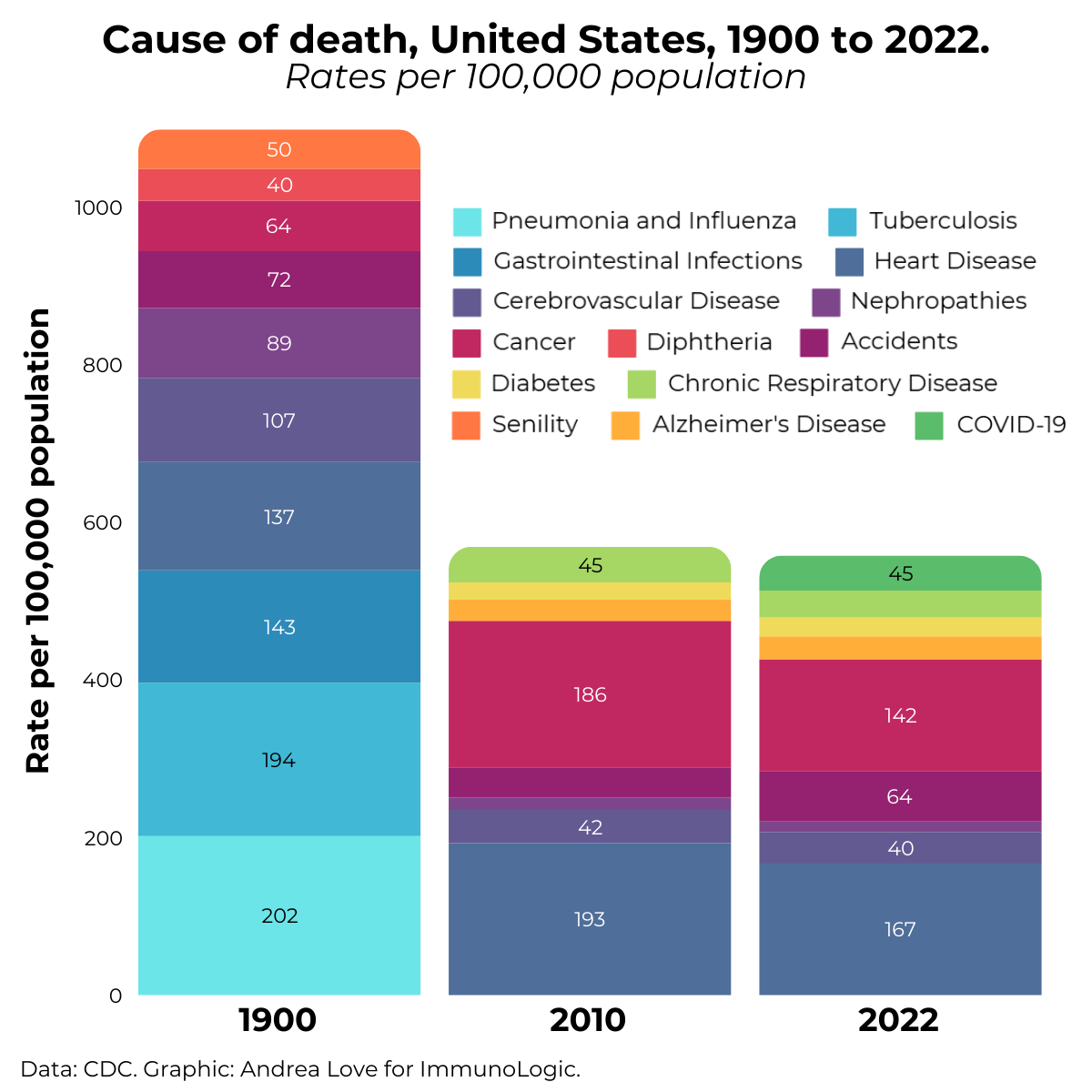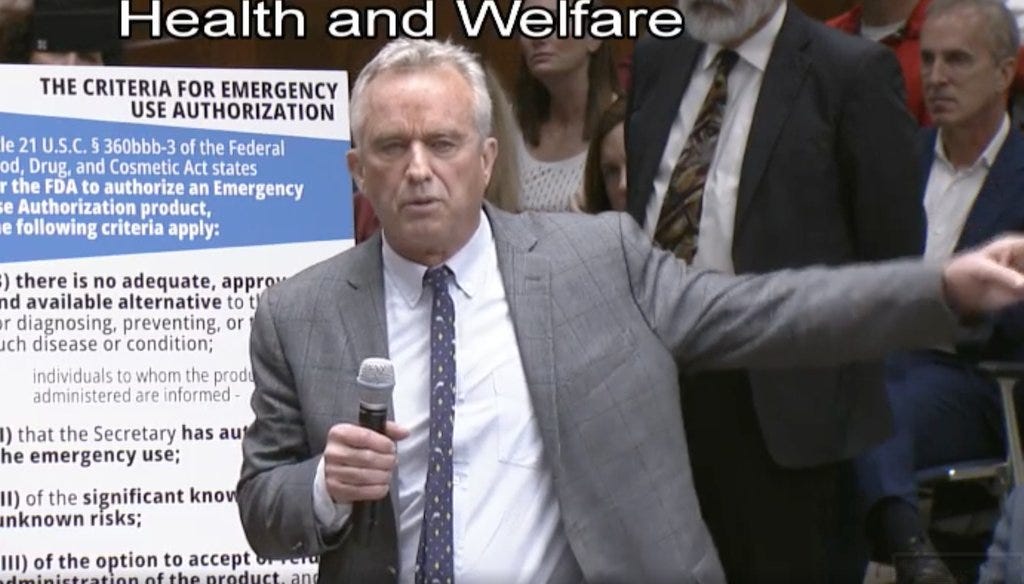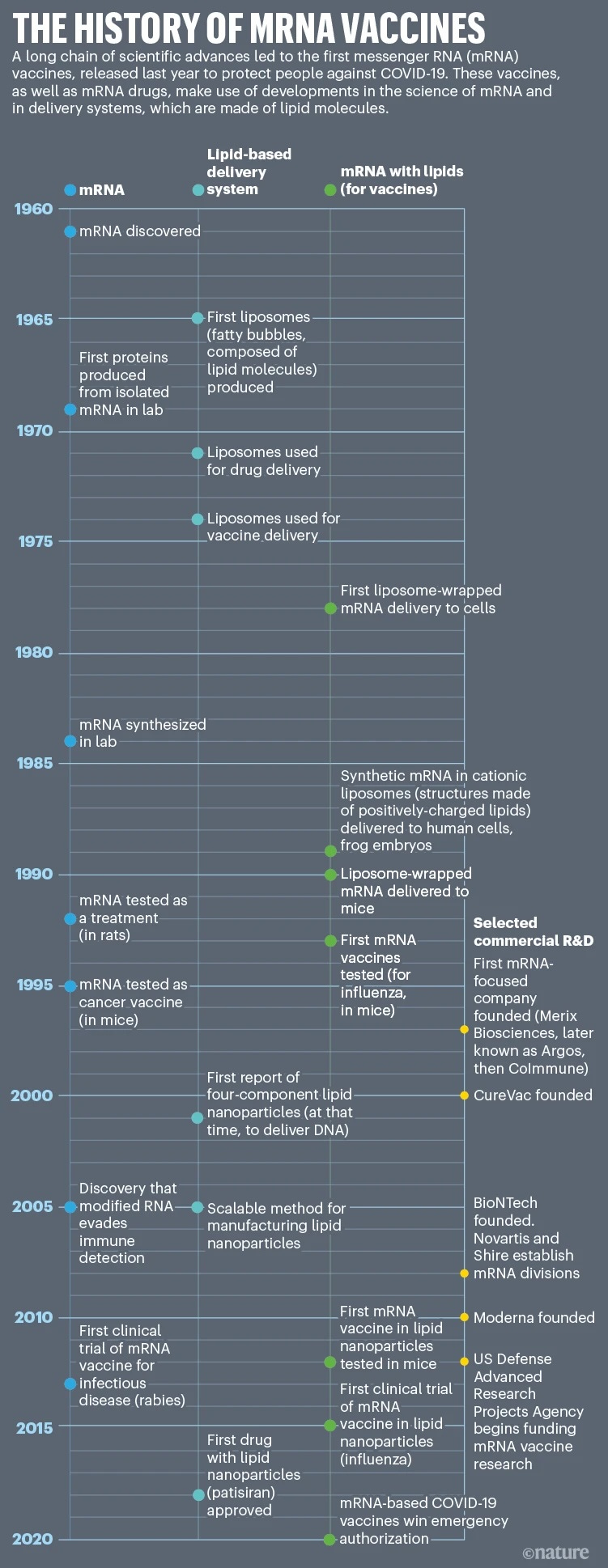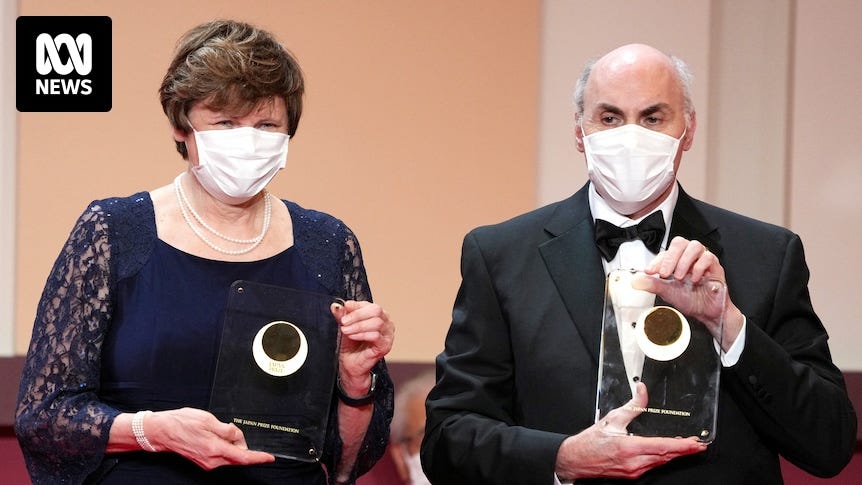The muddled science of MAHA
Don't count on RFK Jr. to make Make America Healthy Again
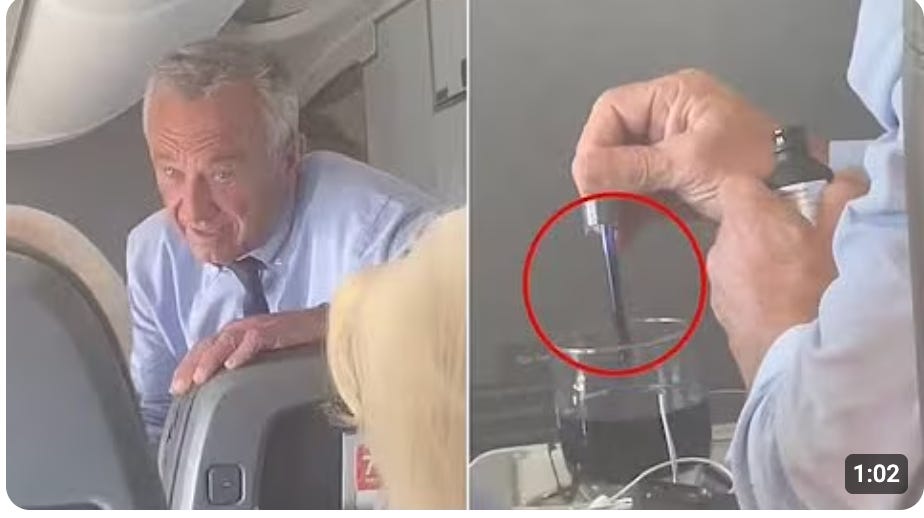
The other day, my neighbor Barry — a classic, decent Red State sort of guy, very much a Trump supporter — came over with a bottle of methylene blue and insisted I try it.
Just 10 drops in a glass of water.
Barry had been turned on to methylene blue by watching a Joe Rogan video on his phone.
Later, I tried to find that video and watch it myself.
It may have been Joe Rogan Experience #2254, on which Rogan’s guest is actor Mel Gibson.
The video [here] is over 2 hours long, but, as actor interviews go, relatively painless.
Mel Gibson comes off as a bright guy. He knows how to tell a story. For example:
Gibson: I got COVID from my gardener. At first it was like, “Did I grab the hose, or what?” I mean, I knew the guy for 20 years. We both went to the same hospital. He died and I didn't. I think we both got remdesivir, which is not good.
Rogan: Not good. Causes kidney failure.
Gibson: I know. I couldn't walk for three months after I had that stuff. I found out afterwards it kills you. That's why I wonder about Fauci…
Rogan: Oh, you should wonder about that guy…
Methylene blue comes up shortly thereafter, when Gibson tells an anecdote about unconventional cancer drugs:
Gibson: I'll tell you a good story. Okay, I have three friends. All three of them had stage-four cancer. All three of them don't have cancer right now. At all. And they had some serious stuff going on. What was it they took? You've heard…
Rogan: Ivermectin and fenbendazole…?
Gibson: Yeah. And I’m hearing people mention methylene blue…
Rogan: Yeah, methylene blue, which was a fabric dye. It was a textile dye. Now they find it has profound effects on your mitochondria…
Gibson: This stuff works, man…
Barry had spent $65 on his bottle of methylene blue, so it was presumably the real deal.
He was slightly disappointed when I knew what methylene blue was.
But the moment he mentioned it, I suffered flashbacks to high school biology class, hearing those voices:
“Hey! Are you sure this frog is dead? Its heart is still beating!”
“It’s pithed.”
“You’d be pithed too, if I were cutting you open like this…”
Being a history of technology buff, I also happened to know, as Joe Rogan does, that methylene blue was first synthesized in 1878 by BASF in Germany for use as a cotton dye, and shortly thereafter (1880) found to be excellent cell stain by microbiologist Robert Koch.
Koch is famous for Koch’s Postulates, the four criteria that must be met to show that a microbe causes a particular disease.
If Mel Gibson is actually taking methylene blue — that’s not clear from the interview, he only says he’s heard people talk about it — he’s not the only celebrity user.
Running around on YouTube and TikTok are snippets of video of our Secretary of Health and Human Services, Robert F. Kennedy, Jr. putting drops of methylene blue in a glass of water. Just search for “RFK Jr's Mystery Blue Drink.”
Here’s one explanation [here] as to why RFK Jr. might be taking methylene blue, from Dr. Rahi Victory, a Canadian obstetrician:
Why is he actually putting it into his water? Well, there are some people that think it can help with anti-aging, and other people are saying it's useful for brain toxicity, reducing risks of toxicity in the brain, improving brain function, maybe even improving long term memory.
But there's absolutely zero data to support those assertions…. There are certainly no controlled trials or concrete evidence, beyond one study that says it may reduce depression symptoms.
So before you start running off to drop methylene blue into your water, just remember, not everything you see on the internet is true.
I drank the 10 drops.
It tasted terrible.
The next morning, my pee was blue.
If I’d had asparagus for dinner, I shudder to think what the result would have been.
Methylene blue didn’t do anything for my brain. MAHA still has me very confused.
It’s also increased my anxiety level.
In June, RFK Jr. appointed Dr. Robert W. Malone to the Department of Health and Human Services (HHS) Advisory Committee on Immunization Practices.
Malone, who has a popular Substack [here], has been banging on forever about how mRNA vaccines may have horrible long-term health consequences.
Kennedy’s HHS now provides a helpful link to the COVID-19 mRNA vaccine harms research collection [here].
I follow the link.
My hand goes to my chest after I look up the word ‘myocarditis’.
I know about vampires. I start to wonder what a protein spike through the heart feels like.
I shuffle through my Covid vaccination cards.
I long ago resigned myself to living with the genes I’ve been dealt, but this is a new twist.
There it is: Moderna, March 5, 2021. mRNA-1273.
That shot, as I recall, was a weird one, administered by no-nonsense female U.S. Army sergeant in uniform.
At the time, the Cherokee County Health Department needed all the help it could get.
The experience was like being a bit player in an episode of M.A.S.H., but not as funny.
I decide to put off thinking about this year’s Covid booster until my brain fog clears.
I figure I have until October to decide. That’s when I usually get my flu shot.
But now I see where that decision may be slipping out of my hand.
On Wednesday, August 27, 2025, RFK Jr. fired the Director of the CDC, Susan Monarez, a Ph.D. in microbiology and immunology.
She was a Trump nominee. It was just a month after she was confirmed for the job by the Senate.
On Thursday, three CDC officials who worked under Monarez resigned in protest, leaving the CDC in some disarray.
In my Red State, pharmacies are prohibiting from administering vaccines that aren’t on the CDC’s ACIP’s list of recommendations.
ACIP stands for Advisory Committee on Immunization Practices.
On June 9, 2025, RFK Jr. fired all 17 sitting members of the previous ACIP, and replaced them with his eight of his own picks.
It’s not clear what they’ll end up recommending.
In the meantime, CVS — the pharmacy — has decided to put off offering the Covid vaccine in 16 states.
If I really, really want the Covid shot, I could probably shop around for a doctor willing to prescribe it.
But I have no clue what doctors around here will be thinking.
Times have changed.
Nobody said living in an era of epistemological anarchy would be easy.
I like to think of it as being in front of a baseball pitching machine whose control logic has gone haywire.
It’s serving up one curveball after another at high-speed. They just keep coming at you.
Although some pitches are definitely screwball. Those wellness influencers.
Dealing with it is exhausting.
You can’t just bat away everything by reflex. A few good pitches are mixed up with the bad.
It’s like a kid’s puzzle: “Try and find them!”
As a drill, go through this list at high speed. It’s from a Tweet by RFK Jr. from Oct. 25, 2024 [link]:
psychedelics, peptides, stem cells, raw milk, hyperbaric therapies, chelating compounds, ivermectin, hydroxychloroquine, vitamins, clean foods, sunshine, exercise, nutraceuticals and anything else that advances human health and can't be patented by Pharma.
“Make America Healthy Again” — MAHA — apparently goes back to the title of a book by Dr. Nicole Saphier, a radiologist at Memorial Sloan Kettering in Monmouth, New Jersey.
Dr. Saphier often appears on Fox to comment on health and medical news.
Her book had the publishing misfortune of appearing in April of 2020, just as Covid was getting going in the U.S.
Dr. Saphier has a lot to say, from a doctor’s perspective, about how messed-up the U.S. health care and health insurance system is.
No argument there.
But her advice to individuals about how to stay healthy is pretty much the same as you would have heard from any doctor in the last half-century.
I keep this list around as sort of a touchstone. Those MAHA influencers want to take my eye off the ball:
Eat healthy. Obviously, opinions vary. For this bullet list, I’ll repeat Michael Pollan’s pithy “Eat food. Not too much. Mostly plants.”
Exercise every day. Maybe 20 minutes is a minimum.
Don’t smoke.
Don't drink alcohol in excess. Again, opinions vary.
Keep to a schedule of regular screenings appropriate for your age and sex.
That’s it.
“Make America Healthy Again” reappeared — this time as a political slogan — in August, 2024, shortly after RFK Jr. ended his sputtering campaign for president.
RFK Jr. had originally entered various Democratic primaries to challenge Biden.
Kennedy, after ending his campaign, endorsed Trump.
There was presumably some sort of deal — it’s Trump, after all — but any details are unknown.
A few days before, Kennedy’s running mate for vice president, Nicole Shanahan, had floated her opinion in an interview that RFK Jr. would do an “incredible job” as Secretary of Health and Human Services. [Link]
And ‘Make America Healthy Again’ obviously rhymes with ‘Make America Great Again’.
Traditionally, in U.S., it’s been the Surgeon General who gets to play the bad guy — the scold — in matters relating to health. The famous Surgeon General’s report on Smoking and Health appeared in 1964.
But the Surgeon General is usually a medical doctor, which Kennedy is not.
Although one Surgeon General was a dentist, and another a veterinarian.
At times, the First Lady has been the scold. In 2010, Michelle Obama went after childhood obesity with a campaign called Let’s Move!
After winning the election in November 2024, Trump did indeed nominate Kennedy for secretary of HHS. His nomination was confirmed by the Senate on February 13, 2025.
That was by a 52 to 48 vote, with Mitch McConnell was the only Republican to vote against. McConnell had polio as an infant in 1944, age 2. He was worried Kennedy might get it into his head to do away with polio vaccines.
For comfort, I turn to the wisdom of a former vice president, Dan Quayle. “People that are really very weird,” Quayle once said, “can get into sensitive positions and have a tremendous impact on history.”
It doesn’t take a degree in semiotics to draw a circle around the word ‘Again’ in “Make America Healthy Again.”
Was America healthier once before?
That’s not an easy question to answer.
If we look at one metric, life expectancy at birth, in the U.S. it was 78.4 years in 2023, up from a dip to 76.4 during Covid, but below a 2014 all-time peak of 78.9 years.
‘Not dying’ is not exactly the same thing as living healthy.
Although it’s a good start.
In the past, people would have died much earlier in life of something else, such as influenza.
I’m in love with the work of a certain Dr. Andrea Love. She blogs as ‘ImmunoLogic’, here. She’s got a colorful chart based on CDC numbers:
But the year 1900 may be too early to use as the Before Time.
If we go back to 1950, we had smoking and heart attacks.
Deaths from heart disease have declined 70% since 1950.
Infant mortality has declined around 80% since 1950.
The decline in deaths from cancer — all sorts, but primarily lung — is not so dramatic, but down about 25% from a peak in 1990.
And we shouldn’t forget a few things that, numbers-wise, don’t make a Top Ten list. After 1995, HIV went from a death sentence to a manageable chronic disease almost overnight.
So what’s gotten worse?
Like I said, not dying is not the same as living healthy.
According to the CDC, about 60% of U.S. adults live with at least one chronic disease, and 42% have two or more.
Now, when people live longer they’re more likely to have one of those. Arthritis, for example, makes a sizable contribution to that 60%.
But the most damning things in the U.S. numbers are chronic diseases that are (mostly) preventable, the big ones being obesity and diabetes.
Diabetes — Type 2 — is a late-onset disease. It’s probably best to look at its prevalence among the 65+, 29.2%.
As for obesity, a study published in The Lancet last November found that 75% of American adults are either ‘overweight’ or ‘obese’, based on body mass index, BMI.
BMI is admittedly not a perfect metric, but it’s what we’ve got.
Almost 50% of U.S. teens and young adults — ages 15 to 24 — are now either overweight or obese, compared with 29% in 1990.
After the many sins of climate science, we have a right to be wary of scary predictions.
But I can’t resist repeating this one from The Lancet study.
By the year 2050, the way things are going, over 80% of Americans will be obese. And one in three teenagers.
That’s not ‘overweight’. That’s obese.
If anyone wants to Make America Healthy Again, they’ve got their work cut out for them.
Even I can triangulate a link between obesity and diabetes: sugar.
In the old days, physicians used to taste urine when making a diagnosis.
It was known to all of them — starting with those in India around the 7th century BC — that the urine of people with diabetes tasted sweet. For years, diabetes was called ‘the sugar sickness’.
We owe the fancy Latin term diabetes mellitus to English physician Thomas Willis, in 1674. To Willis’ taste, diabetic urine was more honey-sweet, so he added the ‘mellitus’ which means honey.
Sugar is one of RFK Jr.’s ‘issues’.
To his credit, in my opinion.
In an April 22, 2025 press conference he said, “Sugar is poison, and Americans need to know.”
It’s not a novel notion. In 1901, English doctor Willoughby Gardner was quoted in the British Medical Journal saying that sugar should be avoided “like poison” by those prone to obesity, diabetes, or gout.
In a normal person, we’d shrug off RFK Jr.’s remark as a bit of rhetorical overstatement.
Humans have eaten sugar for millennia, since Saccharum officinarum was domesticated in New Guinea around 1,000 B.C.
In the days when people did hard physical labor and lived on the edge of malnutrition, sugar was just a few added cheap calories. It did no damage except to the teeth.
But RFK Jr. is not a normal person. For one, he’s head of a federal agency with a $94.7 billion budget.
On sugar, as on many of his ‘issues’, RFK Jr.’s views are the opposite of measured.
Paracelsus’ dictum — the dose makes the poison — holds no interest.
That can happen to lawyers. They spend years crafting forceful arguments, then end up believing — as in True Believing — their own work.
RFK Jr. has drunk deeply of his own Kool-Aid.
Which makes him come off as — and maybe actually be — a fanatic.
It gets worse.
Instead of making a clear, simple point that parents might understand — ‘Fruit Loops have too much sugar’ — RFK Jr. segues to taking on red dye #40.
For RFK Jr., ‘ultraprocessed foods’ are a rhetorical gateway drug that bring on chemophobia.
Playing on the public’s irrational fear of chemicals — fluoride, glyphosate, red dye #40, you name it — has been part of the environmental lawyer’s playbook forever.
For purposes of litigation, trace amounts of something that sounds scary will do. Modern technology can detect almost any amount of anything.
It’s then the task of the environmental lawyer to ‘link’ that level to something bad — preferably with a highly subjective diagnosis, such as ADHD.
Contemporary obesity and Type 2 diabetes have roots stubbornly anchored in our modern, more-affluent-than-before society. There’s no ‘ban this’ quick fix.
As for chemophobia, I link that to a different sort of deficiency — not dietary, but of STEM education.
If people can’t pronounce the name of something on a food label, there’s help for that: Wikipedia.
And if Fruit Loops really were poisonous, I think we’ve have a lot of dead Millennials on our hands by now.
I sometimes think we should repurpose the phrase ‘long Covid’ to refer to the political hangover the U.S. has experienced after the pandemic.
It doesn’t seem to go away.
I sympathize with people who’d rather forget about Covid.
I’m sick of it, too.
Not literally, thankfully.
I recently decided my constitution was strong enough to try reading The Big Fail, a new book on how the U.S. handled the pandemic from Joe Nocera and Bethany McLean.
It was a bit like re-watching an old horror movie. You know exactly what’s going to happen. But as it plays out, it’s still scary.
I recommend the book. It’s a good contribution to a gaping void.
After other big tragedies in U.S. history — 9/11, for example — we pulled it together to empower bipartisan commissions that looked into what went wrong and what went right.
Today that appears to be out of the question, which is sad.
That the school closings were a bad idea seems to be the sole issue on which a different, post-pandemic consensus is emerging.
The Democrats don’t want a general inquiry into the Covid years for fear it might damage their brand.
The Republicans have staged one inquiry of their own — the House Select Subcommittee on the Coronavirus Pandemic — but were unable to restrain themselves from using it to bash the Democrats at every opportunity.
There’s no center. Just a deadlock of extremes.
All of which reminds me of the fall of the Ottoman Empire.
Not that I was around for that.
So maybe the former Yugoslavia.
I remember a joke I once heard from a Yugoslav who worked at the U.N.: “Yugoslavia! Six republics, five ethnic groups, four languages, three religions, two alphabets. One party!”
When the imperial center falls due to overreach, things tend to fly apart at the periphery.
We’ve had an era of imperial overreach in both Covid and climate science.
Phrases like “Maybe” or “We don't know” were not allowed.
Error was not acknowledged.
The lived experience of people was ignored.
Instead, ‘The Science’ was a handy authoritarian tool for policing thought. Enforcing the hegemony.
Reputable scientists who held dissenting views were ignored, banned, or belittled for not getting with the consensus.
On the lab leak theory, for example, even such an establishment figure as Dr. Robert Redfield, a former CDC director, later said there was “an a priori decision that there's one point of view that we're going to put out there, and anyone who doesn't agree with it is going to be sidelined.”
Take the word ‘denier’. It’s central in the vaccine discussion, and also in climate.
You can only be a denier if there’s some orthodoxy to deny. Recollect the original denier was Simon Peter.
After the hegemony, the deluge. Anything goes.
It’s a state of affairs historian and philosopher of science Paul Feyerabend, one of my favorites, calls ‘epistemological anarchy’.
Life is possible under a regime of epistemological anarchy, but it can be tiring.
You have to study those curveballs one pitch at a time.
The mRNA vaccines were one of the few success stories to come out of the pandemic.
Yet they, too, seemed to be getting sucked into the grievance vortex, as into some black hole.
I don’t pretend to understand that phenomenon entirely.
Although the mRNA vaccines were indeed oversold.
They successfully prevented Covid infections from becoming severe.
And that was about it. They didn’t block or prevent new infections.
‘Transmission’, to bring back that word.
There were a number cases where people got the vaccine and then went on to get Covid. These were disingenuously written off by the powers-that-were as ‘breakthrough infections’.
A few were high-profile.
In October 2022, CDC director Rochelle Walensky tested positive, despite having had the bivalent booster a month before.
During the pandemic, I would read anything by Dr. Jay Bhattacharya, then a professor of medicine at Stanford Med and now head of the National Institutes of Health (NIH).
Dr. Bhattacharya got the Covid vaccine in April, 2021 and a case of Covid four months later, in August.
RFK Jr.’s take on the Covid pandemic can be found in his 2021 book, The Real Anthony Fauci: Bill Gates, Big Pharma, and the Global War on Democracy and Public Health.
I try to keep an actively open mind. I read it.
I suppose I was expecting 480 pages of unhinged diatribe.
It was not that.
It reads like a collection of legal briefs, with zillions of footnotes to all kinds of studies and papers.
For one example, RFK Jr. makes an extended case for hydroxychloroquine, the over-the-counter malaria drug that some doctors, when first confronting Covid, believed would reduce hospitalization and death if administered quickly at the first sign of infection.
I could be convinced about hydroxychloroquine. But I’d want to put in the time to check out all those references.
And I remember back when I covered the campaign to close the Indian Point nuclear power plant in Buchanan, New York, just up the Hudson from Manhattan.
The crusade to close Indian Point was led by Riverkeeper, a self-appointed environmental watchdog group for which for many years RFK Jr. was lead attorney.
Riverkeeper’s legal filings were deftly skilled at taking some factoid with a kernel of truthiness and spinning it into cotton candy, suitable for easy lay jury and media consumption.
It was true, for example, that thousands of fish eggs and fish larvae were sucked into Indian Point’s cooling water intakes, ending their short fishy lives.
But there are umpteen million fish eggs and larvae in the Hudson.
After a spin by Riverkeeper’s attorneys, Indian Point was ‘killing millions of fish’.
The organization would also supply artwork to the media — photos of dead fish floating in the river.
Which turned out to have been taken during a seasonal algae bloom, and had nothing to do with the nuclear plant.
For the environmental trial lawyer, every member of the public is a victim.
You need a sympathetic victim with whom the jury can identify.
No litigant-victim’s problem results from bad luck or poor lifestyle choices.
Children are really good, since they are, by presumption, innocent victims.
The entity the trial lawyer seeks to hold responsible is preferably some corporation with deep pockets, and part of Big Something.
The burden of proof is simple: whatever it takes to convince a jury. Or extract a settlement.
A highly desirable rule of evidence is one that keeps opposing views out of the courtroom altogether.
Failing that, opposing experts can be discredited on ‘meta’ grounds, such as who they’ve ever taken money from.
Their work is ipso facto tainted. The jury is encouraged to disregard it without looking at its actual content. An expert who has taken any amount of money from Big Something can’t be right about anything.
RFK Jr. knows that playbook by heart. He almost wrote it.
On Monday, June 9, 2025, RFK Jr. fired all 17 sitting members of the CDC's Advisory Committee on Immunization Practices (ACIP).
RFK Jr. explained in a Wall Street Journal opinion piece that the panel “has been plagued with persistent conflicts of interest.” [Here]
Now, if RFK Jr. were just another congenital lawyer — one cynically willing to say anything to win — that would be one thing.
But — as I said before — RFK Jr. has actually come to believe his own stuff.
On December 6, 2021, RFK Jr. told Louisiana state legislators that the Covid mRNA vaccine was “the deadliest vaccine ever made.” A photo:
On Wednesday, June 11, 2025, Kennedy appointed seven new experts to the ACIP, including Dr. Robert W. Malone.
Within the MAHA movement, Malone — who was involved in mRNA research in the late 1980s — gets the sort of deference the CIA gives a high-value defector.
Some in MAHA say he ‘invented’ mRNA. And look: he’s turned against it.
The actual history of mRNA technology is, as usual, pretty complicated.
Two basic things are needed to make an mRNA vaccine: the correct sequence for the messenger RNA strand itself, and the lipid (fatty bubbles) delivery system.
mRNA was discovered in 1961. Liposomes were also discovered in 1961, but not described in print until 1964.
In 1978, researchers found they could use liposomes to transport mRNA into mouse and human cells. Once inside, the mRNA would induce the production of proteins.
Malone’s 1987 contribution was an improvement in the recipe for the liposome bubbles. Putting a positive charge on them helped the RNA stay in place.
It took some time to learn how to synthesize ‘biologically active’ RNA in a lab. But that was in hand by the late 1980s.
At that point, all the puzzle pieces were on the table.
Indeed, in 1993, researchers at Transgène, a small biotech firm in Strasbourg, France, elicited an antiviral immune response in mice by packaging an mRNA strand in a liposome.
Getting the mRNA sequence just right was tricky. You needed it to (a) elicit the immune response you wanted, but (b) not provoke the body’s immune system into attacking the mRNA.
The vaccine business is a strange one. Let’s just say that for a long time mRNA vaccines were considered a bad bet for commercialization.
Then came Covid and Operation Warp Speed.
Here’s the entire timeline, in a graphic from the journal Nature:
It’s early to write history, but it’s starting to look like the success of Operation Warp Speed was a bit of a one-off.
A lot of things happened to come together in a fortuitous way.
The virus was sequenced quickly. The sequence of the initial Wuhan variant appeared unofficially on the internet on December 28, 2019, within a month of the first reported cases.
More or less the same sequence was published officially by China’s CDC on January 10, 2020.
The Covid virus, like all coronaviruses, had that distinctive spike protein, which was like a little flag.
The U.S. National Institutes of Health had been studying spike proteins for years. It knew a lot about them.
The beauty of the mRNA approach was that the payload of the vaccine, once gotten right, could be synthesized easily and quickly. For conventional vaccines, some piece of the pathogen is typically put through generations of mutation and weakening, which can take years.
I don’t want to downplay the work involved, but that biology was a manageable short step. The more significant innovations of Operation Warp Speed were in areas like manufacturing and logistics.
But also unusual was the fast-track testing, done in parallel, considered necessary in the emergency. Both Pfizer and Moderna agreed to long-term monitoring using the Vaccine Adverse Event Reporting System, VAERS.
In the short-term, reports of adverse effects from the 2020 test groups averaged around 0.5%, which was considered acceptable in light of the vaccines’ benefit.
The Pfizer-BioNTech vaccine received emergency use authorization from the FDA on December 11, 2020. Moderna’s was approved a week later.
That was just about a year from the initial reports of infections, unprecedented in vaccine development.
In the movie, that cues the triumphal ending.
Music swells over footage of Katalin Karikó and Drew Weissman accepting the 2023 Nobel Prize for Medicine in Stockholm “for their discoveries concerning nucleoside base modifications that enabled the development of effective mRNA vaccines against COVID-19”:
Sadly, life is not a movie.
Whatever it is, it continues to unspool.
No mRNA-based drug of any class, vaccine or therapeutic, has yet to get FDA approval since the Covid vaccines.
And that’s looking less and less likely, for ideological reasons.
Science-by-diktat, it turns out, is still around. It’s just in different hands.
So no scientific revolution in Thomas Kuhn’s sense. More like a palace coup.
The environmental zealots of the 1970s often tried to get blanket bans on entire technologies, such as nuclear power and genetically engineered crops.
On August 5, 2025, Kennedy announced that the HHS would terminate 22 mRNA vaccine development projects funded by BARDA, the Biomedical Advanced Research and Development Agency, worth about $500 million.
Although no one in the Trump administration wants to be the guy who deprives the public of some miracle mRNA drug that happens to cure cancer. You pick that up if you parse the pronunciamentos closely, as one once did with Pravda.
So banning mRNA technology is not an official goal at HHS.
But that distinction may be too subtle for state legislators trying to follow HHS’s lead.
No fewer than 12 states have passed, or seriously considered, various sorts of anti-mRNA legislation.
A Montana bill that — fortunately — failed in February would have kept mRNA vaccines out of the state, and made administering one a misdemeanor.
The curveballs will just keep coming.
The bad pitches we can only bat away one at a time.
It’s a lot of work.
But living in epistemological anarchy is probably better than living under an authoritarian consensus.
Science, like politics, is a messy human business. That’s just the way it is.
In the future, we might look back with nostalgia at the simpler days when you more-or-less could trust what the CDC was telling you.
That feeling, I’m sure, will pass.
We’re not in that Kansas anymore.


